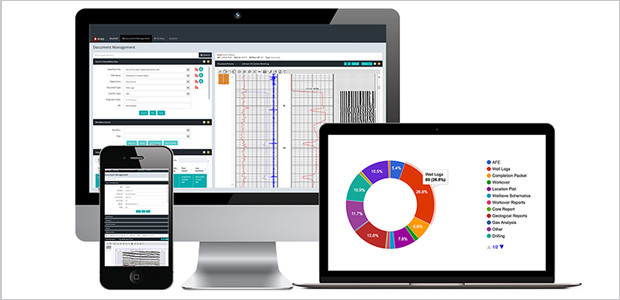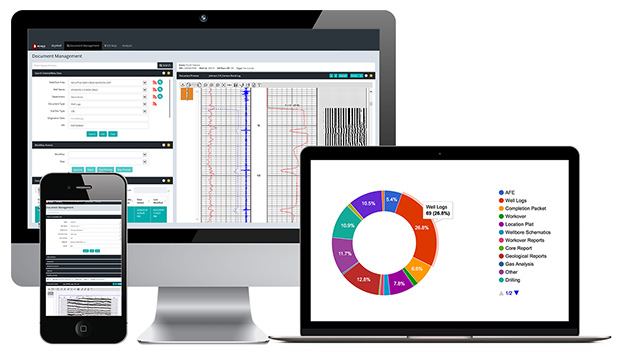
Growth Enabler
Software Optimizes Well Data Management
By Rex Womble
DALLAS–As a rapidly growing independent oil and gas company, Parsley Energy faced a mounting asset information challenge. With ever-increasing numbers of producing wells and continued drilling activity in the Permian Basin, Parsley’s peer-leading growth profile required a well information solution agile enough to keep pace with its operational momentum.
Parsley Energy was founded in 2008 as a two-person startup. It now has 233 employees supporting its business operations in its headquarters in Austin, Tx., and its Permian field office in Midland, Tx. The company’s production expanded from fewer than 200 barrels of oil equivalent in the first quarter of 2011 to 22,000 boe for full-year 2015, and is expected to reach 36,000-38,000 boe by the end of 2016. It operates nearly 800 wells, most of which are located in 14 production units on its 90,300-acre leasehold in the stacked pay core of the Midland Basin.
With 85 percent of its total $460 million-$510 million development expenditure program for 2016 devoted to drilling and completion, Parsley Energy anticipates completing 75-83 gross horizontal wells in the Midland Basin and another five to seven gross horizontal wells in the Southern Delaware Basin, along with three to six gross vertical completions by year’s end.
As the company continues to develop its substantial inventory of drilling locations in Permian resource plays, it also continues to make strategic property acquisitions to augment its future growth potential. In fact, in the first half of 2016, Parsley acquired 23,953 net acres in the Midland Basin and 17,726 net acres in the Southern Delaware Basin.
A primary challenge facing Parsley was figuring out how to effectively manage and analyze all the data from its expanding field operations to extract the knowledge needed to make timely decisions with confidence. As a result of its fast growth, the company accumulated tens of thousands of well related datasets and documents in a short amount of time distributed across operated wells, nonoperated assets, nonproducing wells, and even divested properties.
The company’s engineering, geoscience, land, production and regulatory staff require access to well information for research purposes and to guide decision making. Parsley’s well files were initially stored on an internal shared network drive, but staff was often unable to find the needed information in a timely manner. Complicated folder structures, inconsistent file naming, and multiple versions of a given document created barriers for users, resulting in significant delays as staff hunted for data across multiple departmental systems.
Parsley’s initial attempts to improve access to well information included a custom well file management system built on top of a leading enterprise content management platform. Tailoring this solution to the company’s needs took 18 months to develop and when it was finally delivered, it was not widely accepted by users. Tagging was available, but not enforced, leaving key data missing that could add important context to a document (such as well name and department).
Searching for information was complicated and forced users to navigate to documents through multiple file libraries and often returned hundreds of irrelevant search results. Moreover, Parsley’s staff had no way to quickly understand what a document actually contained, delaying the process further as users downloaded and opened multiple files in order to scan content.
Ultimately, the custom solution did not provide enough flexibility to accommodate dynamic growth. For example, adding a new well to the system was problematic and time consuming, and forced users to store information incorrectly, such as newly drilled wells in the old network drive, for example.
‘Intelligent’ Solution
Seeking a better way to manage its well data while keeping pace with its changing operational portfolio, Parsley turned to a cloud-based electronic well file solution with machine learning capabilities. The software provides its staff with centralized information that can be accessed securely from any device, adequate context and data validation for structuring well information, and the ability to intelligently search and preview document content.
To accomplish this, data from the custom well file system had to be migrated to the digital well information software, which was a daunting task given the large volume of data that needed to be moved and accurately classified. More than 50,000 well files–the equivalent of 150,000 pages–were loaded into the new solution in less than two months by leveraging high-speed document processing and machine learning technology. Because many of the well files were merely scanned images of physical documents, the process used optical character recognition (OCR) to convert images into a machine-readable form that could be indexed and searched.
An important final step in migrating well file data was tagging each document with key information to describe its content. However, such important information as well name or department were inconsistently used and located within documents, making it difficult even for human readers to quickly identify metadata. The intelligent software’s document processing technology applied smart algorithms to automatically extract required metadata, accelerating accurate classification of well files.
The software provides configurable data taxonomies that are specific to the unique oil and gas business landscape. Collecting metadata and enforcing minimum metadata requirements helped ensure that all documents fit into the common structure, and included state, county, well name, department and document type.
With the well files migrated and tagged, staff from across the company were given access to the software’s powerful search capabilities, which could be accessed on tablets, smart phones and other Web-enabled devices. Leveraging the underlying metadata and taxonomy, users were able to quickly navigate to well information. Additional search features included keyword searching on OCR text, document preview, and search term highlighting within a document.
The solution also enables users to find wells of interest visually on a map. The GIS interface combines the location of wells with geospatial data (such as leases and pipelines) to provide an operational view of wells with easy “drill down” to detailed well information. Additionally, the solution features sophisticated data analytics to provide important insights into the well information being managed.
Bottom-Line Benefits
The intelligent well file solution has reduced the time Parsley’s personnel spend looking for well information by as much as 60 percent. When multiplied by the 134 Parsley employees currently using the software, the time savings translate to huge productivity gains, with staff spending less time looking for data and more time on higher-value work.
The information gaps that previously existed between systems and departments are bridged by the software. Parsley is using the solution to manage data for 48 high-value types of well information. Well data are now tracked as soon as the company’s land department obtains plat details for a wellsite, cutting the time it used to take to add a new well from months to minutes.
Establishing a common well file taxonomy and enforcing minimum metadata standards has dramatically improved well information access and accuracy. From a desktop computer in the office or a mobile device in the field, Parsley personnel are able to quickly find the well information they need through an intelligent search or GIS map.
The combination of search features, document preview and search term highlighting has been an especially important feature, helping users rapidly identify the files they need to work with, all streamlined through one intuitive user interface.
Used daily across the company, the well file solution has become an important tool for many departments. For instance, Parsley’s drilling and regulatory departments benefit from easier management and sharing of drilling, completion and stimulation data. And the geoscience department now relies on the solution to manage and search an extensive electronic well log library.
Intelligent well file software dramatically reduces the time oil and gas company personnel spend looking for well information while giving users powerful new search, data access and analytical capabilities using tablets, smart phones and other Web-enabled devices.
Reduced IT Costs
Parsley’s information technology department also has benefited from the cloud-based architecture, which has reduced IT administration time and the costs associated with maintaining an internal system. Moreover, the company has seen a 20 percent decrease in IT support requests as a result of the user-friendly interface and overall improvement to how users find and use well data.
At a glance, well information administrators can now see a breakdown of data across departments and regions using analytic dashboards. With interactive charts and graphs, the solution provides valuable insight and analysis for well file management, an important capability as the volume of asset information that must be optimized continues to grow. For example, performing a data completeness check or enforcing minimum well file standards for regulatory compliance is expedited, helping to improve data quality and lower risks.
While the system gives users on-demand access from mobile devices, access is limited in remote areas of the company’s operations where cellular coverage is sparse. As improvements to wireless communication are made across the Permian Basin, Parsley anticipates more mobile use cases for the software in the field. For instance, extended mobile device connectivity will enable staff to access critical data (such as wellbore diagrams and schematics) from remote locations, further enhancing the ability to monitor and respond to issues in the field.
The company also wants to use the well file solution to securely deliver data outside the corporate firewall as the need increases to share data with partners. It plans to streamline this largely manual process with the software’s out-of-the-box well information sharing and security features.
Parsley Energy’s continued growth and success depend on its ability to make sound drilling and production decisions. Through agile technology, document classification, and intelligent search functionality, the well information software is delivering the data the company needs to drive informed decision making and sustain its momentum.

Rex Womble is chief executive officer and co-founder of Archeio Technologies in Dallas, a provider of well information management software that uses machine learning and smart search technologies to help operators access data more efficiently. Womble’s career spans the information technology industry as well as oil and gas, including experience as a petroleum landman. While in IT, Womble was responsible for managing sales for enterprise customers in the technology, energy and banking industries. He holds a B.S. in business management from Louisiana State University.
For other great articles about exploration, drilling, completions and production, subscribe to The American Oil & Gas Reporter and bookmark www.aogr.com.















